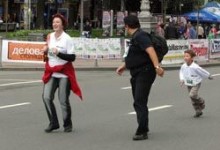The athletes of Dnipropetrovsk and their coaches have sounded the alarm. They say that the preparations for the Euro- 2012 soccer championship are threatening the development of track and field (athletics), often called the “Queen of Sports.” Traditionally, track and field athletes have always practiced at the local stadiums, which, in addition to soccer fields, had running tracks, long-jump pits, throwing sectors, and other infrastructural elements.
However, as the representatives of the Track and Field Federation of Dnipropetrovsk oblast claimed at a recent press conference, nowadays most stadiums have fallen into the hands of investors and are renovated according to commercial demands. For example, the former Metalurh Stadium, which is conveniently situated downtown, will be transformed into the purely soccer Dnipro Stadium without running tracks.
Andrii Fateiev, Distinguished Coach of Ukraine, said that plans are afoot to reconstruct the rest of Dnipropetrovsk’s stadiums the same way and turn them into professional soccer arenas. However, in neighboring Poland, which is also preparing to host the Euro- 2012, stadiums are built with running tracks. The famous Wembley Stadium in London, which was initially built for soccer, will soon have a running track. “The importance of developing athletics is understood all over the world,” emphasized Fateiev. “Unfortunately, Dnipropetrovsk oblast disagrees.”
Oleh Zaichenko, the vice- president of the Track and Field Federation of Dnipropetrovsk oblast, is as worried as his colleague. He says that the Dnipropetrovsk region does not have a single genuine track and field stadium. “Just for the sake of comparison, let’s take the small European country of Slovakia, which has 100 stadiums with synthetic tracks. In Dnipropetrovsk, one of the major cities of Ukraine, reconstruction of the running track at the Meteor Stadium began five years ago. The track base, worth two million hryvnias, has already been laid, but that was the end of the work. It will take another million hryvnias to finish the job. If this is not done, the base will become unusable, and the whole thing will have to be started over from scratch,” Zaichenko explained.
Dnipropetrovsk coaches say that fields that are suitable for beginners to practice on are of absolutely no use to first-class athletes. After one or two practice sessions on the city’s poor-quality tracks athletes are injured, and their recoveries then take from 6 to 12 months. That is why local athletes have to travel to Yalta, Yevpatoria, Mariupil, Luhansk, Donetsk, and Kyiv to do their training.
That is a rather expensive undertaking, as accommodations in these cities do not come cheap. In addition, it is psychologically difficult for athletes to live apart from their families. As a result, many promising athletes often change their places of residence and start representing other regions.
The lack of sports equipment is scandalous and frustrating: athletes and coaches pay for every item themselves. However, even if a discus, hammer, or javelin is available, there is no place in Dnipropetrovsk to practice with them.
According to Zaichenko, insufficient financing is also slowing down the development of track and field for children. “Owing to the ruined infrastructure, some parents are refusing to send their kids to specialized athletic schools. Sports schools have to look for sponsors to purchase uniforms or bring the children to competitions.”
In spite of these problems, 42 sports schools are still operating in Dnipropetrovsk and their pupils are achieving some successes. In 2008 the combined Dnipropetrovsk oblast team won the Ukrainian Schoolchildren’s Sports Competition and the Ukrainian Juniors’ Championship. The junior athletes won 36 first prizes, 28 second prizes, and 33 third prizes at various national competitions, setting two world records, two European records, and seven regional ones.
Despite junior athletes’ achievements, the gains made by adult athletes in Dnipropetrovsk oblast are dropping every year because of the lack of proper facilities and equipment. “A total of 254 Ukrainian athletes will go to the Olympic Games in Beijing, and 72 of them will compete in track and field events,” said Zaichenko, “but only two of them represent Dnipropetrovsk oblast.
“I should remind you that only four athletes from Dnipropetrovsk competed in Athens in 2004, but at the Sydney Olympics in 2000 there were 12 from our city. The future does not look bright at the very time when track and field, especially running and heel-and- toe walking, are the most popular sports in the world. Almost 10 percent of the world’s population does track and field, while only 8.4 percent of all people play soccer,” said the vice-president of the Track and Field Federation of Dnipropetrovsk oblast.







